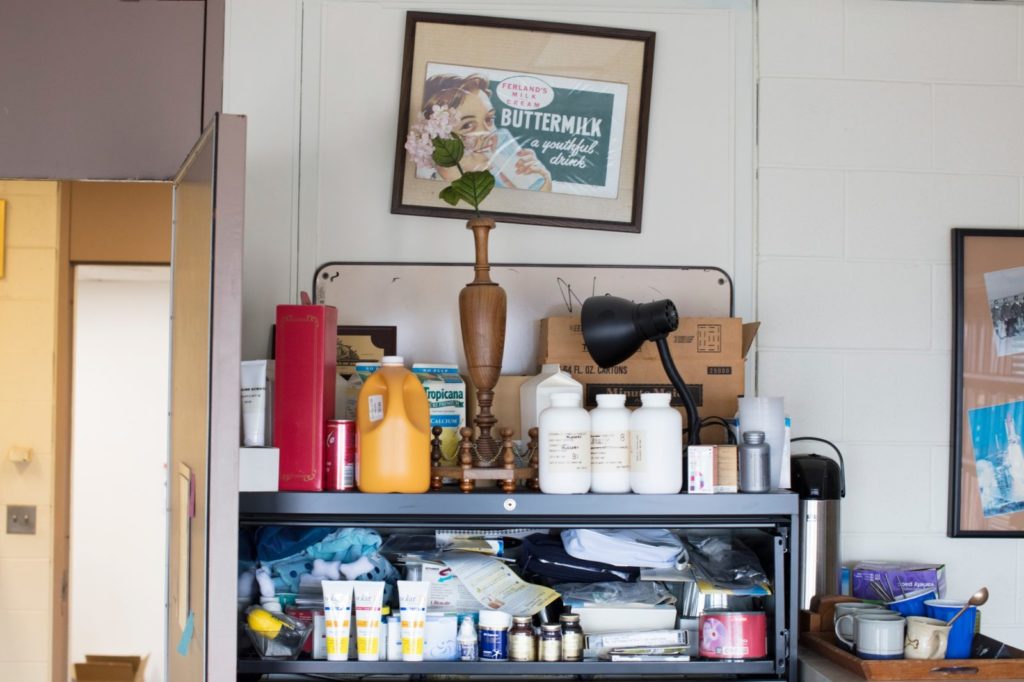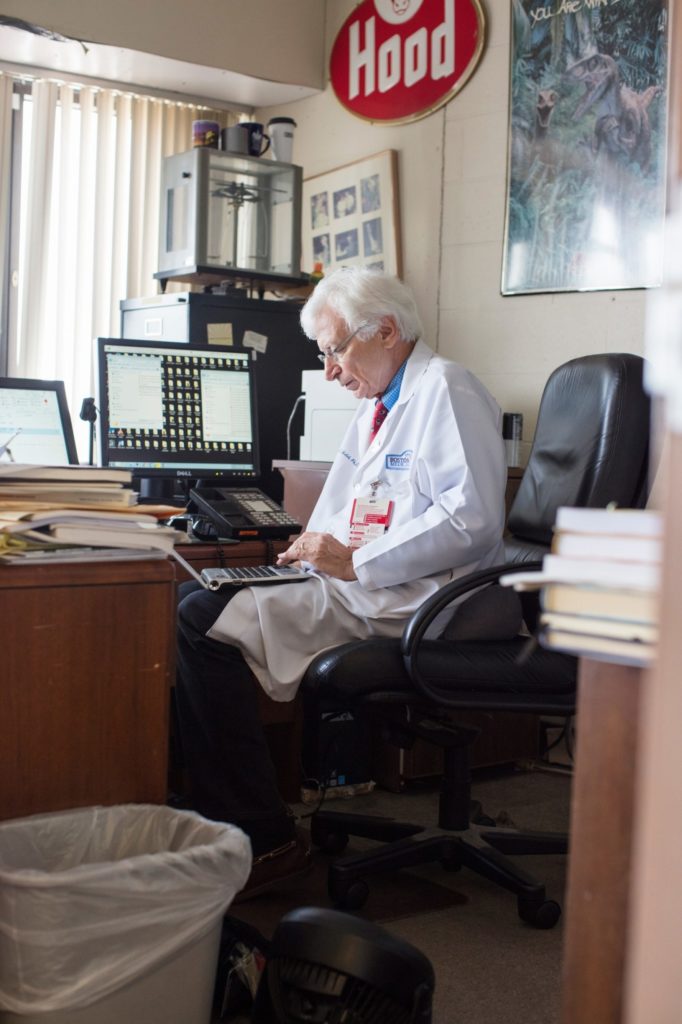The Child Abuse Contrarian
SPECIAL FEATURE, JUSTICE, SCIENCE, 1 Oct 2018
David Armstrong | ProPublica – TRANSCEND Media Service
Michael Holick, a renowned scientist turned expert witness, relies on his own controversial theory to help alleged abusers avoid prison and regain custody of the babies they were accused of harming.
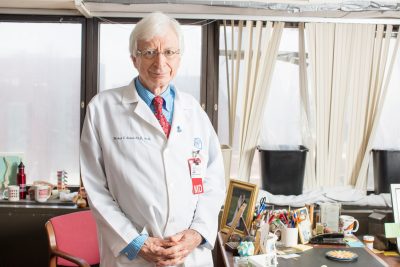
Dr. Michael Holick in the 10th floor office where he has worked since joining the faculty of the Boston University School of Medicine 30 years ago.
M. Scott Brauer, ProPublica
26 Sep 2018 – In September 2016, Jenn Thompson and her boyfriend, Robbie Ray, discovered that she was pregnant. They had met just over a month earlier, through the dating app Tinder, and quickly became inseparable. Robbie would stay at Jenn’s place several nights a week, and on the weekends, they tailgated at football games. The pregnancy was unplanned, but both had recently turned 30 and were ready to start a family. When they went in for an ultrasound appointment, a technician pointed out two tiny circles on the screen: twins. They bought a baby Doppler and Robbie would hold the monitor on Jenn’s stomach so they could listen to the two hearts beating in tandem.
They got married five months later, at the Lutheran church Jenn attended. Robbie moved into her house, in Columbia, South Carolina, across the street from her parents in a tightly packed development of modest, newish homes tucked behind a shopping complex. They converted the second bedroom into a nursery. Jenn found the crib she slept in as an infant and gave it a fresh coat of paint. The babies arrived more than a week early, by C-section — a boy first, and then a girl.
Over Memorial Day weekend, when the twins were 3 weeks old, half a dozen excited family members came to Jenn and Robbie’s home and took turns cradling the twins. The girl seemed particularly fussy. At times, she cried so hard that she seemed unable to catch her breath. Robbie later called it a “scary cry.” But the couple figured she was just colicky. Then, the following Tuesday, as Jenn was feeding her, she noticed swelling and bruising on the baby’s right leg. She told me that she called Robbie, who was at work, driving a truck for a uniform-supply company, to tell him that something was wrong. Jenn’s mother came over and told her to take the baby to the pediatrician. The same doctor had examined the twins just a week earlier and found them to be in good health. This time, he told Jenn to take the infant to the emergency room at nearby Palmetto Health Children’s Hospital immediately.
An X-ray revealed that the baby’s leg was broken in two places, both near the ankle. The new parents said that nothing remarkable, no accidents, had occurred during the previous few days. Robbie wondered aloud if he had unintentionally hurt her while putting lotion on her legs or changing a diaper. Called in by the E.R. staff, Dr. Susan Lamb, a pediatrician specializing in child abuse, noted a pattern of bruising “consistent with an adult hand gripping the calf” and a fracture caused by “extreme” force, according to a South Carolina Department of Social Services report.
The hospital staff then examined the other twin. X-rays revealed a fracture in his left leg. A doctor found bruising on his back. The next day, as Jenn and Robbie sat with the twins at the hospital, social workers and security staff converged on the room. A sheriff’s deputy handed the couple an emergency order to take the twins into state custody.
Some among the medical staff and social workers involved in the case thought that Jenn reacted strangely to the discovery of her children’s injuries. She didn’t show emotion or seem bothered. Her affect was “flat,” according to the D.S.S. report. The hospital’s abuse specialist concluded that the baby girl’s fractures were “diagnostic of physical abuse” and that the bruises were “inflicted.” D.S.S. concluded the boy’s injuries were also the result of abuse. A factor in this determination was that Robbie and Jenn did not have “a plausible explanation” for the injuries. “We had no idea,” Robbie told me later.
To find an explanation, the Rays said, they searched the Internet and eventually discovered a group called Fractured Families. The website was filled with stories of parents who were accused of abuse — falsely, it said — after their children were found to have bone injuries. Jenn told me that she was struck by how similar their experiences were to her own. Jenn made contact with several of the mothers in Fractured Families. They told her that there was a doctor in Boston who might be able to help her.
*******
Michael Holick has a 10th-floor office at Boston University, where he is a professor at the medical school. His windows offer a view of the tree-canopied medical school campus below. A makeshift system of plastic bags and buckets is rigged to collect the rain water that often leaks in. Gray tape binds the air duct, and the tiled floor is stained. Two lab coats hang in the corner and a stethoscope rests on a desk next to photographs of Holick’s wife and two adult children. Holick has worked in this space since he first arrived on campus, 30 years ago.
In the past seven years, Holick said, he has consulted or testified as an expert witness in more than 300 child-abuse cases throughout the U.S. as well as the United Kingdom, New Zealand, Australia, Germany and Canada. In almost every case, he has made the same finding: instead of blaming any injuries on abuse, he has diagnosed the child with a rare genetic disorder, Hypermobile Ehlers-Danlos syndrome, a condition that affects the connective tissues of the skin, bones and joints. A handful of studies on adults have linked EDS to bone fragility, and Holick argues that children with the disorder have weaker bones, which can fracture from normal handling. So far, his theory is not supported by the scientific literature, but Holick is convinced that “thousands, if not tens of thousands,” of parents worldwide have been falsely accused of fracturing their children’s bones. “It’s just terrible,” he told me. “I feel so sorry for these parents.”
In all the cases he has worked on, Holick has never concluded that a child was being abused. On the rare occasions when he didn’t diagnose EDS, he attributed the bone fractures to rickets or Vitamin D deficiency. Many geneticists and bone specialists find it troubling that he diagnoses EDS in nearly 100 percent of the cases he examines. According to the National Institutes of Health, EDS affects, at the most, 0.02 percent of people worldwide. The rate at which Holick diagnoses the disorder “doesn’t fall into the mathematical probability of chance,” Brad Tinkle, a clinical geneticist at Peyton Manning Children’s Hospital, in Indianapolis, said. Holick retorts that his clients don’t come to him by chance; parents contact him after doing their own research and realizing that they or their children have symptoms of EDS. He adds that he hasn’t seen a single actual abuser pretending to have EDS and contacting him in search of a “get out of jail free” card.
Holick regularly diagnoses children with EDS without seeing them in person. “I already know on the phone they have EDS,” he said, adding that he questions the parents about potential symptoms. “I almost don’t have to ask. I know the answer.”
Kenneth Grad was indicted for felony assault and endangering children after X-rays of his infant son at Akron Children’s Hospital revealed 26 fractures of the fingers, arms, legs, ribs and skull, according to court documents. Holick examined the baby’s mother, Laura Grad, and diagnosed classic signs of hypermobility. Without examining the baby, Holick submitted an affidavit attributing the fractures to EDS. However, a test by the family’s pediatrician found that the baby did not have hypermobility. Grad was convicted in December 2014 and sentenced a month later to 24 years in prison. “The mom has EDS and so too likely the child,” Holick said in an email, adding that, if the injuries weren’t due to bone fragility, “the amount of trauma to cause that number of fractures … would likely have resulted in the infant’s death.”
In 2017, he co-published an article about his EDS work in the little-known journal Dermato-Endocrinology, where he is an associate editor. (He was unable to get more prestigious medical journals to publish the study.) In the study, Holick examined the cases of 72 children who the authorities believed had been abused. He diagnosed 67 of them with EDS. In a third of the cases, he based his diagnosis on physical exams of relatives of the children, not the children themselves.
“How can you do that without an exam?” Brendan Lee, the chair of the Molecular and Human Genetics department at Baylor College of Medicine and the director of the Skeletal Dysplasia Clinic at Texas Children’s Hospital, said. He added that hypermobile EDS “is a diagnosis that is made based on a constellation of clinical findings, which you have to do by examination and history.”
Lee and several other experts said that hypermobile EDS typically cannot be diagnosed in children younger than five. Because infants are usually very flexible, they will likely score high on elements of the test given to older patients to determine hyperflexibility, a key aspect of EDS. Also, symptoms of the condition do not usually manifest until later in childhood, or even adulthood. “I would not be comfortable, ever, telling a parent that an infant has (hypermobile) EDS,” Lee said.
There are four studies that Holick consistently cites to support his conclusions. I asked Rodney Grahame, the author of two of those studies and a former president of the British Society for Rheumatology, whether he finds Holick’s theory of a link between EDS and bone fractures in infants to be reasonable. “Not at all,” Grahame responded in an e-mail. “It may ‘stand to reason’, but it is not supported by published scientific research. In adults, other factors are at play including ageing and the menopause, alcohol, smoking which are factors associated with osteoporosis that are not present in infants.”
Cristina Eller Vainicher, the lead author on another paper that Holick frequently cites, said that she can’t entirely discount his thesis, because some studies have suggested that a subset of EDS patients experience fragility fractures during childhood. Still, she wrote in an e-mail, “This does not mean that we could state all children with hypermobile EDS are at high risk of fractures.”
*******
Holick’s credibility as an expert witness is buttressed by a formidable scientific resume, mostly related to his work on Vitamin D. As a graduate student, at the University of Wisconsin, he discovered the active form of Vitamin D, which led to treatments for bone disease in kidney patients and for psoriasis. He later discovered that orange juice helps the body absorb Vitamin D, a finding that led to FDA approval for Vitamin D-fortified orange juice. NASA tapped him to examine bone loss in space. When a mated pair of Komodo dragons at the National Zoo, in Washington, D.C., failed to produce a live hatchling, Holick determined that their glass enclosure was inhibiting Vitamin D production. The dragons soon procreated.
Holick, who is now 72, gives talks around the world on the importance of Vitamin D. He was billed as a “legend” at the most recent annual meeting of the American Association of Clinical Endocrinologists. He has published more than 500 articles in peer-reviewed journals and more than 200 reviews and book chapters. Since 2011, other scientists have cited him almost 110,000 times, making him one of the most frequently cited researchers in the world. He attributes his prolific output to his ability to function with minimal sleep. He has diagnosed himself with a sleep disorder that he said he shares with several notable figures throughout history, including Michelangelo. One day, when I visited him at his office, Holick said he had been there since 2:30 in the morning.
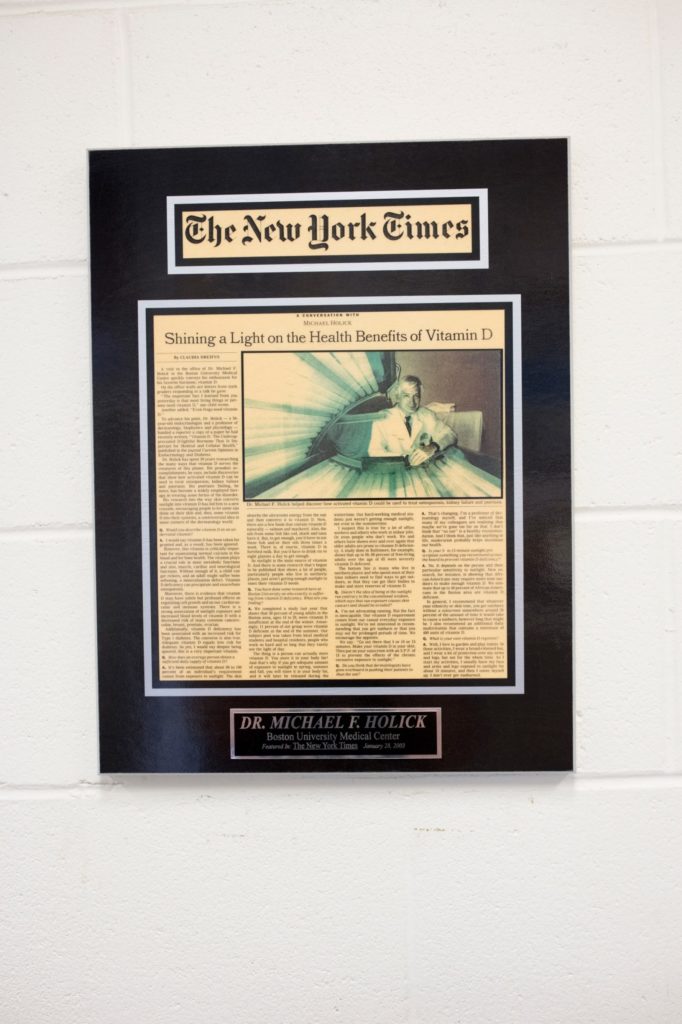
A framed copy hanging on Holick’s office wall of a New York Times feature in which he touts the benefits of vitamin D and poses next to a tanning bed.
(M. Scott Brauer, special to ProPublica)
But Holick’s career has also been dogged by controversy. He came under fire for recommending the use of tanning beds based on research he’d done partly with funding from a foundation established by the Indoor Tanning Association, a relationship that I reported on in The Wall Street Journal. He also published a book called “The UV Advantage,” in which he urged people to soak up unfiltered sun two or three times a week. “Do not be afraid,” Holick wrote. “You are not going to die just because you go out in the sun.”
Soon after Holick’s book came out, Barbara Gilchrest, then the head of the dermatology department at Boston University, called Holick to her office to discuss it. The pair had previously collaborated on research, but now Gilchrest gave Holick two options: he could curb his sunshine proselytization or he could resign as a professor of dermatology, one of several positions he held at the medical school. Holick resigned. Gilchrest later publicly denounced his book as “shlock science.”
“He just went off the deep end and was a poster boy for the tanning industry,” she told me. Holick “ate up” the controversy, she said. “He loves being the provocative bad-boy character.”
*******
Born in Jersey City, New Jersey, Holick knew from an early age that he wanted to be a scientist and a physician. His father, a machinist, and his mother, who worked part-time at a bakery, raised Holick and his four younger siblings. When Holick was 5, the family moved to suburban Linden, New Jersey. He had an early fascination with dinosaurs, and “Jurassic Park” posters hang on his office wall. When he was in the third grade, his father bought him a chemistry set, putting him on a path to an undergraduate degree in chemistry from Seton Hall University.
Almost seven years ago, a couple from New Hampshire called Holick. They were seeking an expert in bone disease to figure out why their son at 7 months old had suffered fractured bones in both arms from no apparent traumatic cause. Doctors believed that the fractures were caused by abuse, and social services had removed the boy from the home. Holick invited the parents to his clinic. When he shook the mother’s hand, Holick recalled, he knew immediately what was going on.
There are 13 types of Ehlers-Danlos syndrome. The most common, and generally considered the least severe, is hypermobile EDS. The most remarkable feature of hypermobile EDS is joints that extend far beyond the normal range. Some people with the condition have made a living as side-show contortionists, using stage names like Elastic Skin Man and the Human Pretzel. That extreme flexibility can also be an advantage in sports like gymnastics and swimming, though the syndrome also makes it easy for joints to dislocate and for skin to bruise.
What Holick noted when he shook the mother’s hand was that her skin was doughy and her joints were flexible — both classic signs of Ehlers-Danlos. He evaluated the baby and found that he also had flexible joints and doughy skin. Far from being abused, Holick concluded, the injured boy had EDS, and this condition predisposed him to weak bones that could fracture from normal handling.
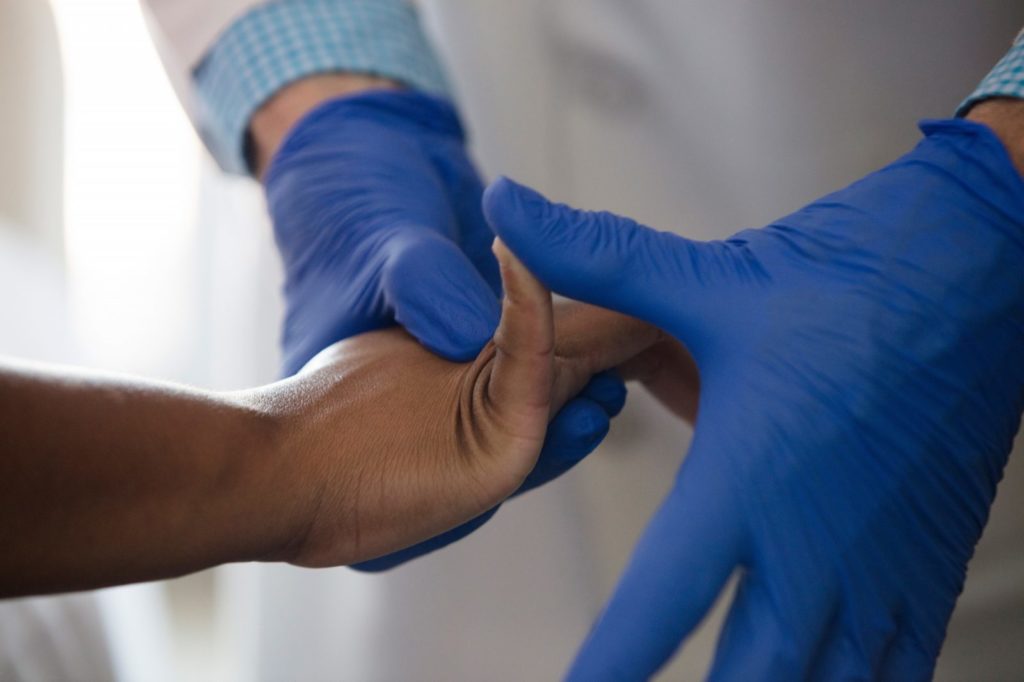
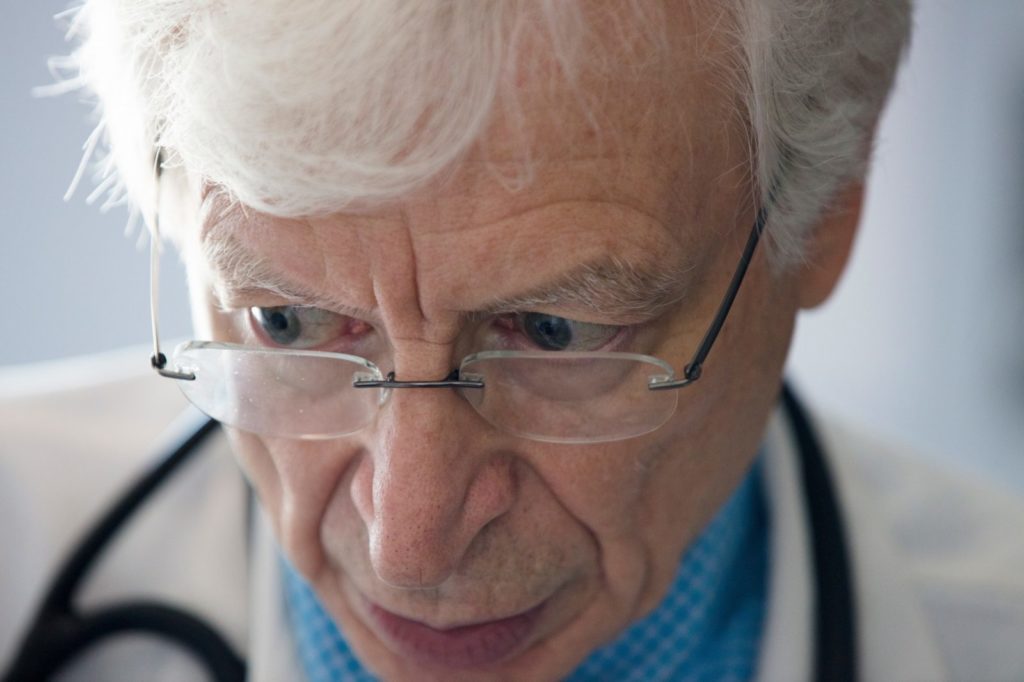 Holick evaluates a patient for Ehlers-Danlos Syndrome, a rare genetic condition. This test determines if the patient is unusually flexible, a common symptom of the disorder. (M. Scott Brauer, special to ProPublica)
Holick evaluates a patient for Ehlers-Danlos Syndrome, a rare genetic condition. This test determines if the patient is unusually flexible, a common symptom of the disorder. (M. Scott Brauer, special to ProPublica)
“It seems so intuitively obvious,” he told me. “No one ever connected the dots. No one in the pediatric or child-abuse community ever made an effort to find other potential mitigating circumstances to explain these fractures, other than a rush to judgment.”
He testified in court on the family’s behalf, and the baby was returned to his parents. Word of Holick’s success began to spread. He now receives pleas for help from parents accused of abuse on almost a daily basis. Holick said he doesn’t charge for his services, though he does solicit donations for his Ehlers-Danlos research. About a quarter of the funding for his EDS research in the past four years — about $125,000 — has come from two families who had abuse charges dropped after Holick intervened in their cases, he said.
Holick is one of the most prominent and sought-after expert witnesses for the defense in child-abuse cases. He told me that about half the parents he assists end up with a positive outcome, such as getting their children back or having abuse charges dismissed. However, he has sometimes claimed a much higher success rate. “Before I started testifying in these court cases on behalf of the family 100% of these cases had been won by the prosecution,” he wrote as part of an unsuccessful plea to the editor of a medical journal to publish his study on EDS and child abuse. “Now that I am testifying on behalf of the family 90% of the cases have been won by the parents and their children have been returned to them without further incident.”
*******
Jenn Ray talked to Holick on July 11, 2017, about six weeks after the state removed the twins from their home. In September, Jenn and Robbie, along with the twins and Jenn’s aunt, who had custody of the children, traveled to Boston to be evaluated at Holick’s clinic. (Jenn and Robbie were allowed to be with the twins as long as the aunt was present.)
Holick noted that Robbie’s skin had a doughy feel and his joints were extremely flexible — he could touch the floor with the palms of his hands without bending his knees. Jenn had a history of bruising easily and feeling lightheaded when she stood up quickly. These were all symptoms of hypermobile EDS. Holick diagnosed them both with the condition.
If one parent has hypermobile EDS, the chances of a child inheriting it are 50 percent. If both have it, the odds increase to 75 percent. Holick determined, with “a high degree of medical certainty,” as he wrote in a report, that the twins had the condition, too, and that their fractures could have been caused by bone fragility associated with EDS.
“It was a relief,” Robbie told me. Jenn finished his thought. “You are so lost and you’re alone,” she said.
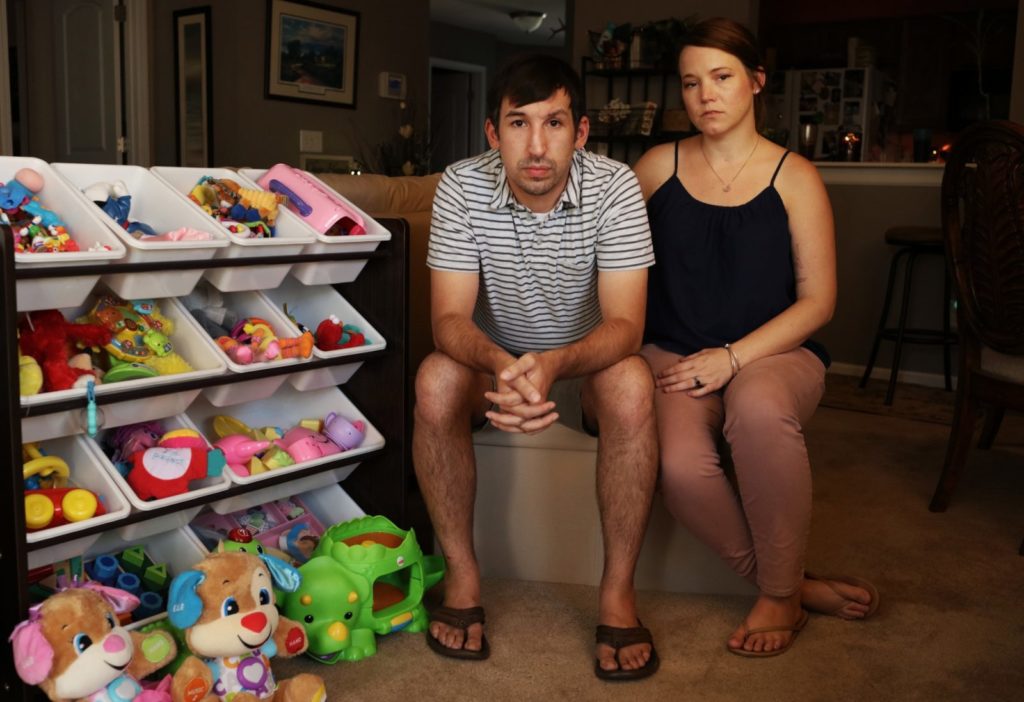
Robbie and Jenn Ray beside buckets of toys for their twin children, who are now in foster care. (Travis Dove for ProPublica)
While state social services officials believed that the injuries were the result of abuse, they could not identify a perpetrator among the people who came in contact with the twins that Memorial Day weekend. Officials did file a neglect charge against the Rays, accusing them of failing to seek prompt medical care for their daughter. The charge, if substantiated by a judge, could have prevented the Rays from regaining custody. A guardian ad litem, assigned by the court to represent the interests of the twins, recommended that the family be reunited. The guardian wrote that she had “witnessed the smile” the children gave when Jenn and Robbie entered the room. The twins’ pediatrician, the guardian reported, did “not see any red flags that would suggest Jennifer or Robbie had anything to do with this.” Finally, the guardian cited Holick’s finding that the children had symptoms of EDS.
Last December, the Rays accepted a deal with the state that approved the return of the children if the couple successfully completed counseling. Even before the counseling was finished, the state allowed the twins to come home for unsupervised weekend visits, starting at Christmas, as the first step toward a permanent reunion.
*******
A 2008 article in the journal Pediatrics looked at some of the nearly 43,000 fractures in children under 3 in the years 1997, 2000 and 2003. Of those cases, the authors found that about one in eight was diagnosed as resulting from child abuse. That proportion doubled, to one in four, for babies who were less than a year old. Doctors say one reason for the difference is that children under a year aren’t walking yet, so they don’t fall on their own or run into things.
Researchers first linked certain types of fractures to child abuse in the 1950s. Since then, the methods for distinguishing accidental injuries from those caused by abuse have become more sophisticated, but there is no test or evaluation that can definitively determine whether a fracture is the result of child abuse.
Fracture cases are often contentious. Many of the children involved are too young to describe what happened to them, and there are usually no witnesses. There are also conditions known to mimic child-abuse injuries. Osteogenesis imperfecta, for instance, often called brittle-bone disease, is widely accepted to cause fractures in babies and infants from normal handling. Unlike with hypermobile EDS, there is a genetic test for brittle-bone disease, and many children’s hospitals routinely check for it in potential abuse cases. It is extremely rare.
The easiest cases to diagnose as child abuse are the most brutal — those with devastating, widespread injuries. The truth is harder to discern when seemingly caring parents bring a child to the doctor for a different ailment and, upon being confronted with evidence of fractures, are at a loss to explain them. A sizable chunk of Holick’s cases fall into this category.
The parents who reach out to Holick have usually contacted other doctors for help, with no success. Often, they have been scorned by child-welfare officials and prosecutors who believe that abuse caused their children’s injuries. They come to Holick looking for a miracle, and when he answers their prayers they react with unabashed gratitude.
“I truly believe you could be an angel put on this earth to show the justice and glory of the almighty,” a father from New Hampshire wrote to Holick in 2016. “The good you’re doing on this earth is amazing, incredible, inspiring, loving, noble, and even incomprehensible.”
The father had been charged with abuse after his 4-month-old son suffered a broken arm. He said he had simply turned the boy over in the crib, and the baby wiggled and fell a short distance onto the crib mattress. The father heard a crack and the baby stopped moving his left arm. State Circuit Court Judge Susan Carbon initially considered it an unusual injury for a short fall onto a padded surface. “The question is whether the injury was intentional and whether there was more behind the explanation of the fall,” she wrote.
Holick examined the parents and the boy and concluded that they all had EDS. It “could easily explain” the fracture, Holick wrote. He then took the stand and awed the judge. She called his 127-page resume “nothing short of stunning.” The analysis by the state’s medical experts “pales in comparison to Dr. Holick’s detailed explanation,” she wrote.
“In Dr. Holick’s opinion, an infant with these conditions can easily sustain a fracture with ‘normal handling.’ [The child’s] skeletal structure, in Dr. Holick’s view, is extremely fragile. Dr. Holick has seen numerous instances where lesser-trained persons interpreted injuries such as that sustained by [the child] as abuse when, ‘with a very high degree of medical certainty,’ they resulted from EDS, not intentional abuse.” She dismissed the charges against the father.
Watch: The Famous Scientist Who Testifies for Accused Child Abusers
httpv://www.youtube.com/watch?v=oTS2C68kHJE
Michael Holick, a renowned scientist turned expert witness, relies on his own controversial theory to help alleged abusers avoid prison and regain custody of the babies they were accused of harming. (Katie Campbell/ProPublica)
Holick’s legal victories have attracted widespread favorable publicity; ABC’s “20/20” and numerous local news outlets have trumpeted Holick’s expertise. One of his cases was featured on an episode of “Diagnose Me,” on the Discovery Life cable network. In a re-enactment scene, an actor playing Holick tells a tearful mother that he has figured out why her child suffered broken bones. “You have Ehlers-Danlos syndrome,” Holick’s character says. “It’s a very rare disease, and in kids it’s often mistaken for child abuse. I have testified about this before, and I would be happy to do it again for you.”
Like the Rays, many families find Holick through Fractured Families, a nonprofit organization founded by a group of five mothers whose children once had injuries that led to suspicions of abuse. Holick had worked with four of the five, and his intervention was critical in exonerating two of them.
Holick said he is careful to note in his expert reports that he doesn’t know the families he evaluates and is only offering a medical perspective. Still, his tone is hardly neutral. In three recent reports, he referred to the mothers as “delightful.” In an e-mail discussing his testimony in a case in Alabama, Holick told a defense lawyer that he was “hopeful that this lovely family will be reunited as soon as possible.”
Holick does not hide his disdain for the child-protection system, nor his belief that the parents he works with are innocent. In the four months I corresponded with Holick, he frequently forwarded me e-mails from parents accused of abuse. He wrote atop one such message, “Does this sound like a mother who is abusing and neglecting her child?”
In June, a mother from the United Kingdom whose son had 22 rib fractures contacted Holick. The only detail of medical history she offered was that she found out after her pregnancy that she had been Vitamin D deficient. “It is certainly possible that the fractures were due to infantile rickets and vitamin D deficiency,” Holick responded. “It’s also possible that he may have had a genetic disorder that predisposes him to having fractures. It’s known as Ehlers Danlos syndrome.”
********
The mutual enmity between Holick and abuse experts at children’s hospitals is hard to overstate. Lori Frasier, the head of the Division of Child Abuse Pediatrics at Penn State Hershey Medical Center, started encountering Holick in court several years ago. Frasier told me that she was struck by Holick’s arrogance. “Maybe he is feeling like he is really, really smart and seeing something the rest of us can’t see,” she said. He might view himself as “a Copernicus of this century, or Galileo, fighting the status quo.”
Holick describes specialists like Frasier as zealots who, because of their training, see abuse behind nearly every mysterious injury that comes through the hospital door. “I naively assumed people want to be educated,” Holick said. “They don’t. They are child-abuse experts. They have to know.”
Unlike Holick, Frasier serves as an expert witness for both prosecutors and defendants, and recently testified in Nevada for a father accused of child abuse. (The father was acquitted in the case.) She also said that she and her team diagnose abuse in only about 40 percent of the cases they consult on. “We see everything,” she said. “We see mistakes in both directions.”
In May 2016, Holick appeared on a Philadelphia television station, saying that a baby’s injuries were likely the result of EDS and a Vitamin D deficiency, not child abuse. Two days later, Frasier sent a concerned e-mail to Karen Antman, the dean of Boston University Medical School. “Dr. Holick makes statements regarding the infant’s medical condition that have no evidence base,” she wrote, noting that other experts had ruled out EDS in the case, and that even if the boy did have the condition there was no evidence it would make his bones fragile. “He is bringing the reputation of Boston University into disrepute.”
Antman replied with a defense of Holick and said she didn’t need to know the particulars of his expert work. “As a private citizen and a physician, Dr. Holick is entitled to provide consultative services and testify as an expert witness,” she wrote. “As a member of the Boston University School of Medicine faculty, academic freedom allows Dr. Holick to espouse his views without censorship from the University.” Antman declined an interview request for this article but indicated through a spokesperson that she stands by the views she expressed in her e-mail.
Watch: The Doctor Who Says Questionable Science Helps Child Abusers Go Free
httpv://www.youtube.com/watch?v=c5vr4fER5ZE
“Academic freedom is not just about saying what you want,” said John Leventhal, the medical director of the Yale-New Haven Children’s Hospital Child Abuse Program. (Katie Campbell/ProPublica)
The Philadelphia case soon took a turn, when the mother had another baby. At 7 weeks, the infant was diagnosed with a fractured right leg. Holick was interviewed again and said there was “a very high degree of medical certainty” that EDS could explain the injury. “I wouldn’t hesitate to have the children returned to the parents,” Holick said.
Seven months after Frasier complained to Holick’s dean, a pediatric geneticist at the Children’s Hospital at Albany Medical Center also raised concerns about him with B.U. Natasha Shur wrote in an e-mail to Holick’s department head, Alan Farwell, that Holick’s expert findings lacked scientific support. “I hope that you are interested in considering these issues, and the effect of BU and its involvement,” she wrote. Farwell replied that he was aware of Holick’s work and encouraged Shur to invite Holick to an upcoming conference to discuss the issues she had raised. Farwell declined to be interviewed.
Shur, who now works at Children’s National hospital, in Washington, D.C., is frequently called on by legal authorities to determine whether a metabolic bone disorder or other condition might explain injuries that look like they were caused by abuse. “In the majority of fracture cases, I don’t make a medical diagnosis of child abuse,” she said. “Something else has happened.” Nevertheless, she finds Holick’s assertions alarming. When she takes the medical histories of patients with EDS, she told me, they don’t mention frequent fractures or brittle bones. “My patients are the first ones to state, ‘I never fractured as a baby,’” she said. “They have had to deal with joint dislocations, joint pain, but as a whole have not had to deal with unexplained fractures.”
B.U., like most universities, guards the academic freedom of its professors by giving them wide latitude to express controversial views, particularly outside the classroom. B.U. administrators would have to show that Holick’s courtroom utterances lack scientific merit or violate accepted professional standards in order to discipline him, John Wilson, the author of the 2008 book, “Patriotic Correctness: Academic Freedom and its Enemies,” said.
But Holick’s critics argue that his statements fall outside the bounds of academic freedom, because they have profound repercussions for families and children. “Academic freedom is not just about saying what you want,” John Leventhal, the medical director of the Yale-New Haven Children’s Hospital Child Abuse Program, said. In an article for the Journal of the American Medical Association last year, Leventhal and his co-authors said that academic medical centers should take some responsibility for the testimony of physicians who promote “flawed theories” in child-abuse cases. “If medical faculty at these institutions testified under oath that smoking did not cause cancer or that HIV did not cause AIDS, would such testimony be tolerated?” he wrote.
*******
While the medical school has largely supported Holick, under the banner of academic freedom, the affiliated Boston Medical Center — where he is the director of the Bone Health Clinic — has taken a dimmer view of his outside work. The hospital has the busiest trauma center in New England and its child-protection team reviews about 800 cases per year.
In 2014, Robert Sege, a pediatrician on the child-protection team, asked to meet with Holick. Sege wanted to know the basis of Holick’s assessment that Ehlers-Danlos or Vitamin D deficiency could explain fractures in infants. Other than agreeing that Holick provided a detailed explanation of his thinking, the men have different recollections of the meeting. At the end of their conversation, Holick said, Sege “looks me in the eye and said: ‘Holick, it is my recommendation you cease and desist immediately. We are going to make your life miserable.’”
Sege said that this confrontation never happened, and that he left the meeting thinking that Holick was “very convincing.” Sege’s contemporaneous notes, which he shared with me, indicate that the conversation was “very cordial and collegial.” It wasn’t until later, after reviewing relevant literature in the field, that Sege determined that he could not validate the link between EDS and infant bone fractures. “I believe this is his firmly held belief,” Sege, who is now a professor at the Tufts University School of Medicine, said of Holick. “It is not backed by evidence.”
Still, Sege said, one comment of Holick’s unnerved him: Holick told him that he doesn’t recommend that parents in potential abuse cases test for osteogenesis imperfecta, the disease known to cause injuries that look as though they might be the result of abuse. Holick acknowledges advising against testing for the disorder. “It’s incredibly rare,” he said, and the test “will come back negative,” adding to the impression that “you are a child abuser.”
“That is a real red flag,” Sege said. “I am a doctor. I test for all things out there before I go to the thing that is my invention. I test for everything I can. It is alarming to tell someone not to get a test because it might impact your court case.”
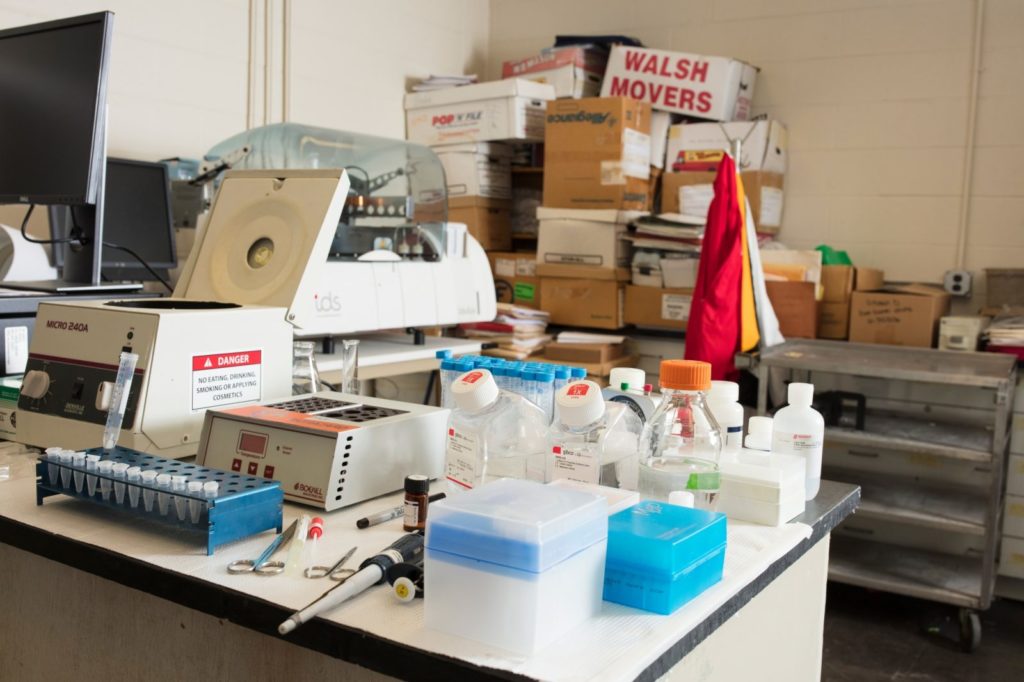
Boxes and equipment inside Holick’s lab at Boston University.
(M. Scott Brauer, special to ProPublica)
In May 2017, Boston Medical Center banned Holick from using “its facilities to treat or evaluate patients under the age of thirteen for any reason,” the hospital said in a statement for this article. It said that its “medical leadership” made the decision, but didn’t explain why. Holick said that complaints about his child-abuse work prompted the edict. The hospital did let Holick consult on one pediatric case that didn’t involve alleged abuse, he and the hospital said. However, he infuriated higher-ups when, at a mother’s request, he also examined twin 2-year-olds who had allegedly been abused. According to Holick, the medical school’s chairman of medicine, David Coleman, told him, “We would be thrilled if you retired and would leave.” He was warned that he would be fired if it happened again. Boston University declined to comment regarding Coleman and said that personnel matters are confidential.
Holick eventually won approval for a research project to study the genetic basis of Ehlers-Danlos, helping him to get around the ban. As part of that research, Holick now evaluates young children in suspected abuse cases in a building shared by Boston University and Boston Medical Center, just across the street from his office.
As concern about Holick’s work has mounted, he has faced increasing scrutiny in court. Lawyers with the Massachusetts Department of Children and Families recently spent several days attacking his credibility and trying to persuade a judge in a child-abuse case not to allow him to testify. Holick said that they brought in other experts to challenge his credentials. They subpoenaed his boss, Alan Farwell, to testify. Finally taking the stand himself, Holick endured a withering cross-examination, he said.
At times, Holick appears surprised and wounded by the criticisms aimed at him. He called some of the e-mails written to his superiors “a little disappointing” and “vitriolic.” He said that those who find fault with his views should publish commentary in medical journals, or do studies of their own. Academics, he said, should want to learn from one another.
Holick compares the attacks on his work to the Salem witch trials. Then, as now, Holick said, “clueless” doctors who were unable to make a proper medical diagnosis blamed scapegoats. “With no experience or knowledge about metabolic bone disease the present day witch hunters will dam [sic] any parent who innocently brings in their child for evaluation,” he wrote to the editor of a medical journal.
Holick said that he has noticed cars lurking at the end of his driveway. He’s tried to approach some of the drivers, but they sped away. “You know, maybe I’m a little paranoid these days,” he said.
*******
This past January, Holick received a phone call so unsettling that he doesn’t even remember who was on the other end. The caller said that the child of a family Holick helped in an abuse case was in the hospital with a serious brain injury, and the father had been arrested.
“Look what you’ve done,” the caller said, according to Holick.
The child was one of Jenn and Robbie Ray’s twins. Officials in South Carolina had agreed to a plan to gradually reunite the family. They‘d had three weekends of unsupervised visits. Now the local newspaper featured a mug shot of Robbie Ray in orange prison garb.
Holick said that he called Jenn Ray to find out what happened, and that he’s confident the latest injuries weren’t caused by abuse, either, but were another complication of EDS.
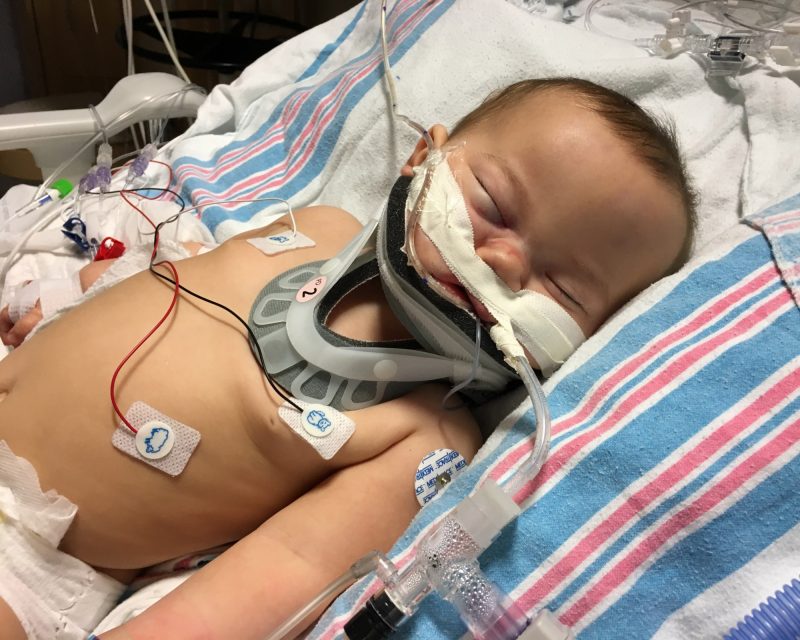
The daughter of Jenn and Robbie Ray in a South Carolina hospital in January, 2018, after being treated for injuries including a broken right leg and a brain bleed. (Photo courtesy of Jenn Ray)
Holick told me that the girl, whom he described as about 2 years old, was in a swing and hit her head. Her father was with her, he said, “and I think that he brought her into the hospital and they gave a clean bill of health. And the next day the daughter had some significant neurological deficits and was bleeding in the head. And so, as a result, he was arrested for felony child abuse. But I believe that what likely happened is just like he was stating: that he was innocently swinging his child in the swing and bumped the head. Unfortunately, the pediatrician and or emergency doctor didn’t actually connect dots and didn’t realize that, if that infant or child has EDS, and if they’re having trauma, they should be more concerned about a brain bleed and not to have sent that child home.”
The explanation is, in many ways, typical of how Holick views these cases. He is quick to declare that a trivial accident has resulted in injuries that can be explained by his diagnosis, that the child has received incompetent medical care from less knowledgeable doctors and that the authorities have rushed to judgment.
Holick’s description of the incident, however, is largely inaccurate. The girl was 8 months old, not 2 years. Robbie wasn’t “innocently swinging his child in the swing.” By his account, he had strapped the baby into a motorized Fisher-Price swing, with the seat about a foot off the floor, while he sat on the couch and fed the other child. He didn’t drive the baby to the hospital; he called 911, and an ambulance took her. In a recording of that call, Robbie seems to be sobbing as he tries to awaken his unconscious daughter. “What’s wrong with her?” he asks the 911 operator. “What happened?”
There was no delay in treatment or missed diagnosis of a brain injury. When the infant arrived at the hospital, the trauma team met her and inserted a tube into her trachea to help her breathe. A CT scan showed that a hematoma on the right side of the brain was shifting the brain to the left. Nor could Holick’s comment that she “bumped her head” explain the damage to the rest of her body. Her right leg was broken near the thigh. A photograph from the hospital shows the infant lying on her back, with one eye swollen shut and bruises on her right eye and nose. There appears to be dried blood on her left hand.
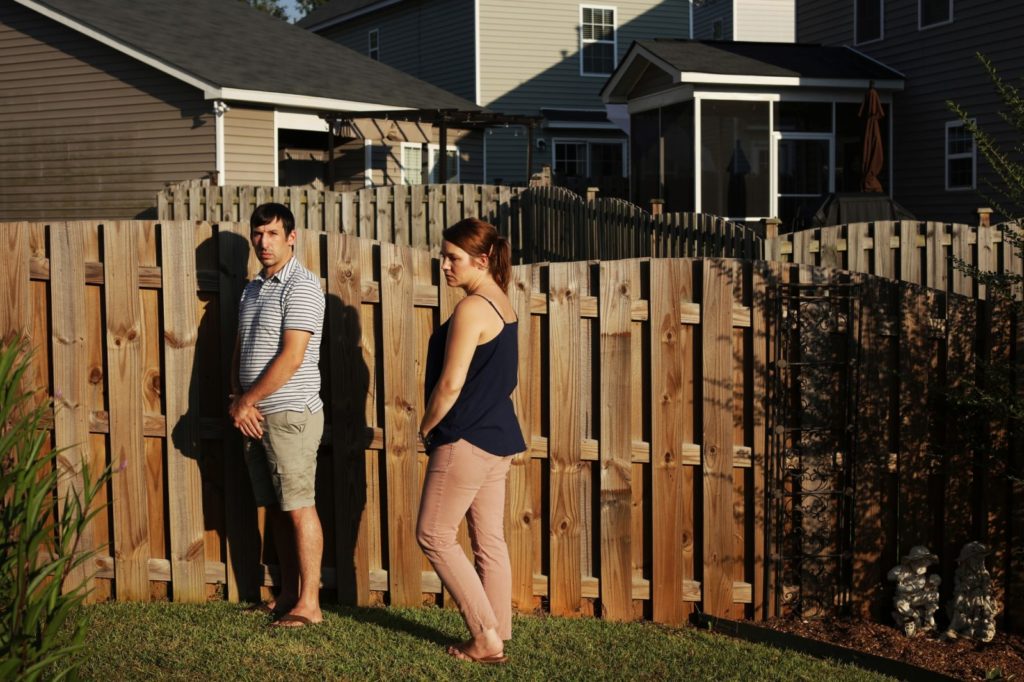
Robbie and Jenn Ray in the backyard of their home in Columbia, South Carolina. They met in August 2016 and were married six months later.
(Travis Dove for ProPublica)
Robbie’s explanation for his daughter’s injuries is that he forgot to snap in the right side of the strap, and she squirmed out, fell forward and hit her head on the metal base of the swing. Robbie says he didn’t see what happened, but heard a thud. When he looked over, the baby was face-down on the carpeted floor. He told state social workers, according to their report, that the baby wasn’t crying or moving and when he picked her up, her head was “just dangling back as he held her.” (Jenn told authorities that she was running an errand at Walmart when her daughter was injured, and showed them a receipt from the trip. As during the prior incident, hospital staff members found her demeanor troubling. She was noted to have a “flat” affect and to be “nonchalant and standoffish.”)
One of the emergency-room doctors who treated the child was skeptical about Robbie’s story. She wrote in her notes that the “mechanism of injury” — a short fall from an indoor swing — “does not fit clinical presentation on arrival.” In a repeat of the first time the girl was brought to the hospital, six months earlier, Susan Lamb, the child-abuse specialist, was called in to evaluate. She didn’t believe Robbie, either. The fall he described couldn’t have caused the girl’s injuries, she concluded.
“At this time with no plausible accident history, [the child] clearly has suffered abusive head trauma and physical abuse,” Lamb wrote.
Three days later, Robbie was at home and heard a knock on the door. He peered out a window and saw several police officers in tactical gear. Robbie was shackled at his wrists and ankles and led away. He was charged with abuse to inflict great bodily injury upon a child, a felony that carries a sentence of as long as 20 years in prison. He pleaded innocent and was released on bail.
Before Robbie faces a criminal trial, the child-abuse allegations will be weighed in family court. If the judge finds that there has been abuse, the D.S.S. has said that it will move to revoke the Jenn and Robbie’s parental rights, which would likely lead to putting the children up for adoption.
Police and the D.S.S. haven’t said what they think happened. When D.S.S. investigators came to the house, they wanted to know about the family’s trip to see Holick, according to a recording Jenn made of the interview. They asked for dates, receipts and the names of everyone who traveled to Boston.
I met with Robbie and Jenn at their home on a steamy day in May. The only sign that something was amiss was the Fractured Families window decal on the back of the Ford Explorer parked in the driveway. Toys were neatly stacked in the living room. The twins’ bedroom remained just as it was in January, when their daughter was hurt. Photographs of the children adorned the refrigerator. Medical and court records were spread across the kitchen table, near where the mechanical swing was set up before police seized it.
Jenn and Robbie talked to me without a lawyer present, taking occasional cigarette breaks on the back patio. The only other people in the home were Jenn’s parents, who stopped by toward the end of the interview, and who are draining their retirement funds to pay for the legal fight to return the twins to Jenn and Robbie. The twins, Jenn told me, are in foster care about 90 miles away.
Joking that she has earned a “Google medical degree,” Jenn offers detailed alternative explanations for her daughter’s injuries and for the twins’ prior fractures. She insists that mistakes by doctors aggravated her daughter’s condition. The only time she became emotional was when talking about the stress that the abuse charges have put on her marriage.
Robbie and Jenn believe that Lamb, the abuse specialist, took an immediate dislike to them after the Memorial Day incident and saw the swing injury as an opportunity to separate them from their children permanently. Jenn called the doctor a “liar” who is “evil,” “wicked” and a “narcissist.” A spokesperson for South Carolina’s Department of Social Services declined to comment. Lamb said that medical-privacy laws prohibited her from discussing the case. A spokesperson for Palmetto Health Children’s Hospital said that child-abuse experts there, including Lamb, are consulted roughly 50 times a year on suspicious injuries. Since 2007, they have found that abuse is medically indicated in about half of the cases they’ve seen.
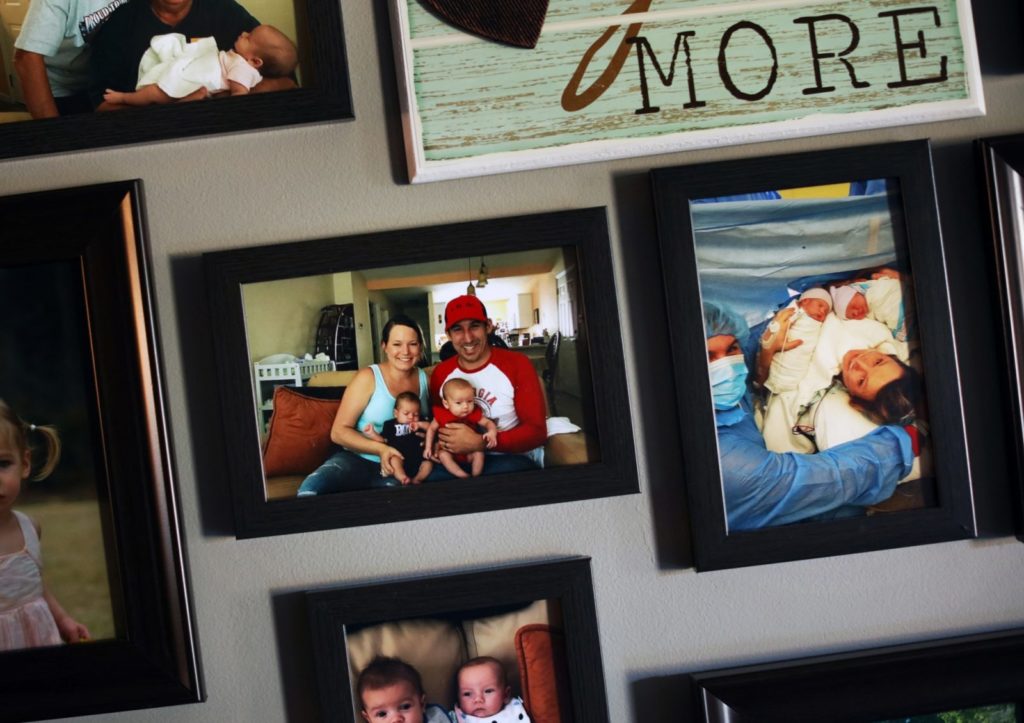
Ray family photos on the wall of their home in Columbia, South Carolina.
(Travis Dove for ProPublica)
The couple contends that their daughter suffers from a metabolic bone disorder — though not necessarily EDS — that worsened the damage from the fall. Jenn thinks the baby may have brittle-bone disease. An orthopedist who evaluated the child concluded otherwise, but Jenn wants a genetic test performed. Both the orthopedist and a new guardian ad litem representing the interests of the infant attribute the injuries to abuse, according to the guardian’s report. Robbie said that he will fight the charges. “If anything, I saved her life,” by calling 911, he said. “I would not hurt my daughter. And that’s why I keep trying to tell people, I know I didn’t do it. I know I didn’t do anything wrong.”
Those weren’t the only criminal charges that Robbie emphatically denied. I asked him about a 2015 misdemeanor conviction for public intoxication that had turned up when the police did a background check. A truck carrying Robbie and a friend, both drunk, had been found on its side in a ditch at 2 a.m., according to police. Robbie was adamant that he knew nothing about it and insisted that it must be a case of stolen identity.
But an intoxicated Robbie is clearly identifiable in a video taken by a police-cruiser camera. “I got really drunk,” Robbie told one officer. “I can’t handle my alcohol.” The video shows him being handcuffed.
When I confronted Robbie about the video, he first reiterated that the incident was “news to me.” He eventually acknowledged that he was at the scene and offered a series of new explanations — for example, that a third person had brought him there after the accident — that are contradicted by the recordings. Nothing has surfaced to indicate alcohol was a factor in either of the alleged abuse incidents.
*******
Holick will be watching the Ray case from Boston. Mistakes happen in medicine, but he realizes that one high-profile misstep on his part could greatly damage his credibility.
“I’m very, very concerned this could upend this whole activity, if even one of the cases of the hundreds turns out to be a child-abuse case,” he said. But he acknowledged the possibility that the case might not turn out as he would like. “You know, these types of things are going to happen,” he said.
In another conversation, he reflected on the impact of his crusade to reunite families divided by child-abuse allegations. “To date,” he said, “almost all of the kids I helped return to parents are happy and well.”
Correction, Sept. 26, 2018: This story originally said that Michael Holick has tenure. B.U.’s medical school does not grant tenure.
_______________________________________________
David Armstrong is a senior reporter at ProPublica specializing in health care investigations and an adjunct professor of journalism at Boston University. david.armstrong@propublica.org
This story is a collaboration between ProPublica and The New Yorker.
Go to Original – propublica.org
DISCLAIMER: The statements, views and opinions expressed in pieces republished here are solely those of the authors and do not necessarily represent those of TMS. In accordance with title 17 U.S.C. section 107, this material is distributed without profit to those who have expressed a prior interest in receiving the included information for research and educational purposes. TMS has no affiliation whatsoever with the originator of this article nor is TMS endorsed or sponsored by the originator. “GO TO ORIGINAL” links are provided as a convenience to our readers and allow for verification of authenticity. However, as originating pages are often updated by their originating host sites, the versions posted may not match the versions our readers view when clicking the “GO TO ORIGINAL” links. This site contains copyrighted material the use of which has not always been specifically authorized by the copyright owner. We are making such material available in our efforts to advance understanding of environmental, political, human rights, economic, democracy, scientific, and social justice issues, etc. We believe this constitutes a ‘fair use’ of any such copyrighted material as provided for in section 107 of the US Copyright Law. In accordance with Title 17 U.S.C. Section 107, the material on this site is distributed without profit to those who have expressed a prior interest in receiving the included information for research and educational purposes. For more information go to: http://www.law.cornell.edu/uscode/17/107.shtml. If you wish to use copyrighted material from this site for purposes of your own that go beyond ‘fair use’, you must obtain permission from the copyright owner.
Read more
Click here to go to the current weekly digest or pick another article:
SPECIAL FEATURE:
- Genocide in Pictures: Worth a Trillion Words
- Genocide in Pictures: Worth a Trillion Words
- Genocide in Pictures: Worth a Trillion Words
JUSTICE:
- Gaza Tribunal Project: Opening Remarks
- The Sarajevo Declaration of the Gaza Tribunal (28 May 2025)
- Gaza Tribunal: Program for Sarajevo Public Sessions, 26-29 May 2025
SCIENCE:
